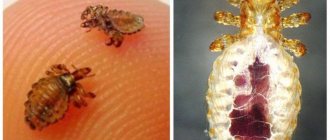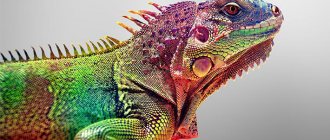- Posted by Olesya Vakhraneva
- Date: December 13, 2018
If your cat is itching, nervous, losing weight, and his fur has lost its former attractive appearance, he may have become infected with hair lice. A knowledgeable owner can quickly eliminate parasites and help the pet.
- 2 Causes of feline trichodectosis and ways of its transmission
- 3 The danger of trichodectosis for cats
- 4 Symptoms of lice-eater infestation in cats
4.1 Diagnosis of trichodectosis
- 6.1 Video: treatment for external parasites of pets
6.2.1 Photo gallery: preparations for external treatment against lice eaters
- 6.3.1 Photo gallery: traditional medicine for treatment against lice
- 7.1 Precautions when caring for a sick cat
What lice eaters, the causative agents of trichodectosis in cats, look like?
Cat lice eaters (Felicola subrastratus) are the causative agents of trichodectosis, a parasitic skin disease that is characterized by thinning of the coat, severe itching and self-injury of the skin when combing it.
Lice-eaters belong to the Trichodectes family, which, unlike blood-sucking lice, is a biting lice. Lice eaters have small body sizes ranging from 1–2 mm, light gray or yellowish color and look translucent. The mouthparts are gnawing, and the paws have sharp hooks that allow the parasite to firmly adhere to the surface of the cat’s skin and fur. The body shape is flat, there are no wings, the head is quite large. Lice-eaters are characterized by a high reproduction rate - each female lays up to hundreds of eggs, attaching them to the base of the hair with very sticky uterine mucus. The development cycle of the parasite takes, depending on favorable conditions, from 2 to 5 weeks, passing through several larval stages. Lice eaters, unlike fleas, do not tend to change hosts. Lice eaters feed on keratin plates of the epidermis of the skin and hair. In the external environment they can survive up to 8 days at room temperature.
Lice eaters are flat, wingless, parasitic insects with a developed gnawing mouthpart.
Possible complications
We wrote above that the parasite violates the integrity of the skin, and accordingly, an infection can enter the dog’s body. A complication can be considered infection with worms, the eggs of which can be carried by lice eaters.
As a result, you will have to treat your poor pet not only for insects, but also for worms.
Open wounds get infected, causing the skin to become inflamed and rot. Such processes cause a deterioration in the animal’s condition, an increase in temperature, and in the absence of the necessary treatment, the dog may die.
This is why it is so important to rid your pet of parasites as soon as possible, otherwise unpleasant consequences may occur.
Important! Baldness of large areas of skin leads to disturbances in body temperature, and the animal may overheat or become hypothermic.
Causes of feline trichodectosis and ways of its transmission
The reservoir of the pathogen is infected animals.
Infection occurs by contact when lice eaters or their eggs are transferred to the fur of a healthy cat:
- in direct contact with infected relatives;
- through care items and bedding;
- kittens become infected from a sick mother;
- The possibility of cats becoming infected from rodents when hunting them cannot be ruled out.
There are also factors that contribute to the infection of cats:
- crowded keeping of cats with insufficient hygiene measures;
- increased air humidity in the room where cats are kept;
- immunodeficiency states, since normally the secretion of the sebaceous glands of cats limits the number of external parasites;
- unbalanced or insufficient nutrition;
- winter-autumn time - during this season lice eaters are most active.
The reservoir for trichodectosis is infected stray animals.
Prevention methods
Preventive measures are not just reinsurance. This is a real opportunity to save your dog from a serious, debilitating disease. Antiparasitic prevention consists of regular:
- examination of animal fur;
- bathing with the use of special zoo shampoos;
- treating places where the pet constantly visits with insectoacaricidal agents;
- washing bedding and clothes.
If the dog lives in an enclosure or kennel on the street, these places also need to be cleaned regularly and sprayed with the indicated preparations once every couple of months. You can also use folk remedies. For example, dried wormwood works well to repel parasites.
If the dog lives in the yard, it is important to ensure that he communicates as little as possible with stray animals. You must wear an anti-parasitic collar on your pet's neck. With proper care, the animal will not face the problem of unwanted lice-eaters.
The danger of trichodectosis for cats
The danger of trichodectosis for cats is:
- possibility of helminth infection; lice eaters are carriers of helminth infections, for example, dipilidia caused by cucumber tapeworm;
- the possibility of allergic skin reactions, especially miliary dermatitis;
- the possibility of the emergence or aggravation of an existing immunodeficiency state and exacerbation of chronic diseases, including viral infections;
- development of anemia;
- weight loss;
- thinning of the coat, the appearance of foci of alopecia (baldness), and a decrease in the attractiveness of the appearance of the coat.
Waste products of parasites visible in a cat’s fur are one of the symptoms of lice-eater infestation
Main features
An attack by lice eaters can be the result of a regular walk with a cat, which accidentally communicates with its yard brothers. Clear symptoms of infection include severe and incessant itching and the appearance of a kind of dandruff due to peeling of the skin. Next comes baldness of individual areas, most often present on the tail, hips, crown of the head, neck, and ears. In a short time the skin becomes rough, inflamed and noticeably swollen. With an advanced form of infection, the animal has a very unsightly appearance.
Ectoparasites worsen a cat’s quality of life, causing the following phenomena:
- scratching the skin until the wounds bleed;
- biting parasites with teeth, which also leads to independent injuries;
- manifestation of irritability, extreme anxiety;
- complete loss of appetite, lack of proper sleep.
It is easy to distinguish lice-eaters from scabies mites or fleas by their great craving for heat. When an infected cat is placed near a fireplace or lamp, the parasites rush en masse to the ends of the hairs, intending to get closer to the heating element. No other species of ectoparasite exhibits this reaction to heat.
Symptoms of lice infestation in cats
The main symptoms of trichodectosis are:
- the cat itches with its paws, tries to catch parasites in its fur with its teeth;
- Due to constant itching, the cat becomes irritable and even aggressive, and may experience insomnia;
- multiple scratches and abrasions from scratching are visible on the skin; with the addition of secondary bacterial or fungal flora, dermatitis develops;
- small crawling insects, as well as their metabolic products, are noticeable in the wool;
- the coat becomes dull and sparse;
- in places of greatest concentration of lice-eaters, areas of baldness appear;
- dandruff appears.
With trichodectosis, areas of baldness form
Diagnosis of trichodectosis
The diagnosis is established based on an examination of the cat, a questioning of its owner about the development of the disease, as well as when lice eaters and their eggs are found on the cat’s skin and fur. To verify the diagnosis, parasites are combed out of the fur and examined under a microscope to clarify their species.
You can make the diagnosis yourself, since lice eaters have a peculiarity - they are very heat-loving. If you bring a cat to a heat source, for example, to a radiator, then after 5–10 minutes small moving insects will appear on the surface of its fur. This trait is characteristic only of lice eaters; fleas, lice, and skin mites do not show it.
Near a heat source, lice eaters, trying to get closer to it, rise to the surface of the fur - this is their distinctive feature
Initial examination
As soon as the first signs of infection appear, you should do an initial examination of your pet yourself:
- To do this, choose a more illuminated place and, spreading the fur, carefully examine it.
- When you see grains, transfer them to a cotton swab. Then, immerse the contents in warm water. If a red or pink spot appears, it is fleas.
- Transparent droplets on the hairs and well attached are lice eggs.
- If you look for places with evenly trimmed hair, and your pet is itching, these are lice eaters. To detect them, just look at them under a lamp or the rays of the sun. Parasites love heat, so when the fur is heated, they will crawl to the ends of the hair. In this situation, you can determine the number of parasites.
Stages of development of feline trichodectosis
In the development of trichodectosis, 3 stages can be distinguished, the duration of each of them is determined by the number of pathogens, the state of the cat’s immune system, as well as environmental conditions:
- initial stage - there are still few parasites, the cat feels satisfactory, sometimes itches with its paw, there may be occasional scratches on the skin;
- stage of the height of the disease - with an increase in the number of lice-eaters, all the symptoms typical of trichodectosis appear: thinning of the coat and areas of baldness;
- severe skin itching;
- multiple traces of scratching on the cat’s skin;
- disturbance of general well-being and behavior;
- dandruff appears;
- allergic reactions: this intensifies skin itching, which ceases to depend on the activity of parasites, as well as their number, and becomes permanent and intense;
- redness and swelling of the skin around the lesions;
- weight loss;
- viral leukemia;
Signs of the presence of a parasite
Recognizing signs of a pet's infestation with cat lice is based on the animal's uncharacteristic habits. At a certain point, it begins to behave differently, which should make the owners worry about the pet.
You can determine what happened to the animal and that it needs help:
- by his restless behavior, irritability;
- for sleep disorders;
- by absent-minded behavior, lethargy, weakness in movement;
- frequent biting of fur while licking;
- by constant scratching.
You should also pay attention to a number of external changes:
- The animal's fur takes on an unhealthy appearance.
- The cat's skin becomes covered with wounds and abrasions. This is the result of frequent scratching of the animal and bites. Thus, the pet tries to stop severe itching and get rid of parasites.
- A rash, roughness and inflammation appear on the skin.
- The cat develops dandruff.
- The animal begins to go bald. Often in separate areas.
Important! Hair loss is an already advanced case. This means that cat hairworm is present in the animal’s fur in large quantities.
A lethargic pet is a bad sign
Treatment of trichodectosis in cats
The following are used in the treatment of trichodectosis:
- preparations for external treatment - destroy lice eaters: drops on the withers - convenient form, very easy to use, ensures the destruction of lice eaters and long-term protection against them: Frontline Spot On;
- Stronghold;
- Leopard;
- Fiprex;
- Advantage;
- In-Up Complex;
- Frontline;
- Rolf Club;
- Flickar;
- Neostomozana;
- Tavegil;
- Sinulox;
- Itraconazole;
- Milbemax;
- Gamavit;
Video: treatment for external parasites of pets
Preparations for external treatment
Effective means for external treatment against lice:
| A drug | Compound | Operating principle | Price, rub |
| Frontline Spot-On; drops on the withers | Fipronil | Kills parasitic insects and mites 24–48 hours after application. Protects against repeated attacks by lice for 4–6 weeks. Do not bathe for 48 hours after treatment. Can be used by pregnant and lactating women. Not allowed for kittens under 8 weeks | 466 |
| Stronghold, drops on the withers | Selamectin | Destroys parasitic insects, skin mites and roundworms. Kills eggs and larvae. Can be used by pregnant and lactating women. Not allowed for kittens under 6 weeks. You can wash your cat 2 hours after use. The action lasts 1 month | from 330 |
| Leopard, drops on the withers | Fipronil, diflubenzuron, dicarboximide | Destroys adult and larval forms of parasitic insects and mites. The protective effect lasts 1 month. Not for pregnant, lactating, kittens under 8 weeks. Do not bathe for 3 days after application | from 162 |
| Frontline, spray | Fipronil | Destroys parasitic insects and ticks. Protection against insects for up to 40 days. You cannot bathe 2 days before use, as well as 2 days after it. Suitable for pregnant and lactating cats, kittens from 2 days of age | 970 for 100 ml |
| Rolf Club, shampoo | Permethrin | Destroys parasitic insects. Not for lactating kittens under 2 months | 315 for 400 ml |
| Phytoelite, shampoo | Permethrin, decoctions of wormwood and celandine | 107 for 220 ml |
First, spray or drops are applied; then wait the time specified in the instructions for the drug and bathe the cat with medicated shampoo.
Photo gallery: preparations for external treatment against lice eaters
Frontline spray can be used in pregnant and lactating cats, as well as in kittens from 2 days of age
Bars drops protect against attacks by ticks and parasitic insects
Stronghold destroys parasitic insects, skin mites and roundworms
Traditional medicine
Traditional medicine can be used at the early stage of lice-eater infestation, when the number of parasites is still small and there are no signs of complications. Repeated bathing of the pet in decoctions is used:
- wormwood;
- chamomile;
- successions.
The bathing product is prepared as follows:
- Take 100 g of dry grass or 600 g of fresh.
- Pour in two liters of boiling water.
- Boil over very low heat for 15 minutes or keep for half an hour in a water bath.
- Remove from heat or water bath.
- Leave for an hour.
- Strain.
- Add water to the required volume and bathe the pet.
Photo gallery: traditional medicine for treatment against lice
Wormwood infusion is used for bathing cats to get rid of parasitic insects
An infusion of string is used for bathing in cases of minor infestation by lice eaters.
Chamomile infusion requires several applications when bathing to get rid of lice in case of minor infestation
Features of treatment of pregnant cats and kittens
It is important to prevent the development of lice-eater infestation in pregnant cats and kittens, since they have the highest risk of complications due to physiological immunodeficiency. Pregnant cats with trichodectosis necessarily infect newborn kittens. Trichodectosis in kittens is very difficult, they are stunted in growth, and secondary infectious complications often occur that can lead to death. Both pregnant cats and kittens from 2 days of age can use Frontline spray.
Other means
In addition to those described above, there are also other types of products that protect against fleas, ticks and lice - key chains and tablets.
- key fob works by transmitting signals in the ultrasonic range and repelling both blood-sucking insects and ticks. The cost of such a product ranges from 1,500 rubles to 5,000. Manufacturers of such devices assure that the key fob is valid for 2 years.
- In addition to key chains, there is another product that has an insectoacaricidal effect - chewable tablets . The validity period of such tablets is from one (Frontline Nesgard) to three months (Bravecto). The cost of the product is quite high - from 800 to 1500 rubles per Frontine tablet and from 1300 to 1800 rubles per Bravecto tablet.
The tablet is a wet treat that is soaked in the active ingredient. After the dog eats it, the ingredients penetrate through the gastrointestinal tract into the blood and remain there for the entire duration of action.
The advantage of this remedy is that any blood-sucking insect or tick will definitely die if bitten. A significant disadvantage is that if the substance enters the animal’s blood, it cannot be removed until the entire period of action has expired. The only way is a complete blood transfusion.
Tablets should be used with extreme caution for miniature dogs or animals prone to allergic reactions.
The danger of lice-eating cats for human health
There is no need to be afraid of lice-eaters parasitizing humans, but accidental parasite bites are possible in close contact with an infected cat, which can result in:
- development of an allergic reaction;
- cucumber tapeworm infection;
- infection with bacteria or fungi.
Children are especially vulnerable, so they are not allowed to interact with an infected cat until it is treated.
Lice eaters are carriers of dipylidia
Precautions when caring for a sick cat
Precautionary measures are simple, since modern means quickly destroy lice eaters:
- it is necessary to treat the cat with the drug (spray or drops) as quickly as possible;
- carry out processing with gloves and a disposable cape to avoid contact with parasites;
- the cat must be isolated until the parasites are destroyed;
- To destroy lice eaters, as well as their eggs, wet cleaning is carried out in the apartment with wiping of surfaces with solutions: Neostomazan 2%;
- Ecocide;
- Ectomina;
How to protect your pet from disease?
Treatment at home can remove parasites in a few weeks, however, it is lengthy and labor-intensive. It is much easier to avoid infection of the animal. To do this you need to take a number of simple measures:
- Regularly inspect your pet for parasites at home. If you notice insects or white husks on his fur that look like tick eggs, you should immediately treat the dog with insecticidal preparations.
- Limit your pet’s contact with other animals not only while walking, but also when visiting public places, for example, veterinary hospitals and exhibitions.
- In the cold season, when the risk of infection is higher, it is recommended to use special anti-parasitic collars that will help avoid infection.
The dog breeder also needs to monitor the pet’s diet, bathe the dog regularly, and keep its bedding clean. Puppies need to be dewormed and have all the required vaccinations so that they do not pick up parasites during their first walk.











